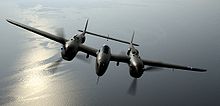Lost Squadron (Operation Bolero)
The Lost Squadron , in German Verlorene Staffel , consisted of the two Rotten Tomcat Green and Tomcat Yellow and is the most famous season of Operation Bolero .
History of the season
Under the command of two Boeing B-17 Flying Fortress bombers , six P-38 Lightning were to be transferred from the USA to England . After a refueling stop in Greenland on July 15, 1942, the next stopover was to be in Iceland . Due to bad weather and problems with the radio links, the navigators in the B-17s lost their bearings. After a long random flight, the group had to return to Greenland, but could not reach an airfield due to lack of fuel. All eight planes landed safely on the Greenland ice sheet, around 150 kilometers southwest of the city that is now called Tasiilaq . All crew members were almost uninjured and were rescued by the US Navy after a few days.
Search and first rescue
From 1981 the squadron was in several expeditions and with z. T. considerable technical and financial effort sought. The effort was initially greatly underestimated because, according to various eyewitnesses, the planes were sighted on the surface of the ice in the early 1960s. In fact, in 1986, the B-17 “Big Stoop” was the first aircraft to be discovered at a depth of 72 meters at the time.
In 1992 one of the P-38s was recovered. She was christened Glacier Girl, is now flying again and can be seen at airshows mainly in the USA. Originally, the B-17 bombers were also supposed to be recovered, but their structure turned out to be too weak, so that they were almost completely destroyed by ice and snow, and so the recovery and restoration costs would be disproportionate to the market value of the aircraft. The significantly better armored P-38s were buried in good condition and preserved in the ice. The remaining five lightnings are currently at a depth of approx. 100 meters below the surface.
Salvage project
Dieter Herrmann, a journalist and graduate engineer, started the Lost Squadron Recovery (LSR) project . The "Association for the Recovery of Historic Vehicles", a group of international enthusiasts and specialists, has supported him so far. LSR has set itself the task of recovering the five remaining P-38s buried in the Greenland ice sheet, transporting them to Europe and making them airworthy again.
At least one of the P-38s is to be restored by the Bundeswehr Air Force Museum . Museums and collectors have expressed interest in the others.
The Greenland authorities granted the salvage permit, but the financing of the project could not be secured in the past.
A troop of more than 300 mostly voluntary helpers, consisting of pilots, rescue specialists, doctors, cooks and logisticians as well as other helpers, would spend the summer on the ice sheet for the rescue. A shaft should first be melted using a wedge-shaped melter. Then steam jets would create a cave around the aircraft. The Lightnings are then to be broken up and taken to the top and shipped from there to Germany.


